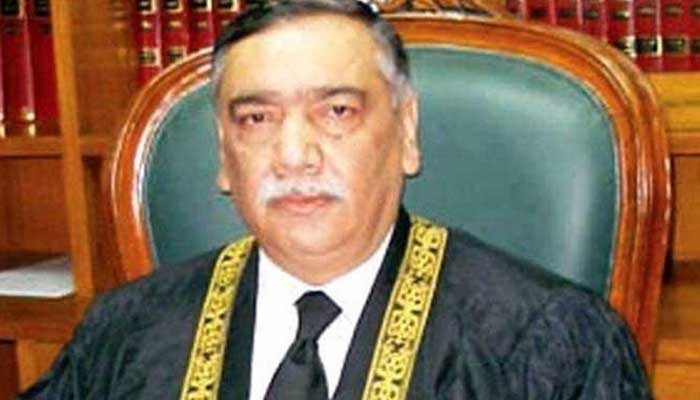Judge’s video scandal: Video to be useful when it’s produced before court, says CJP
A three-member bench of the apex court, headed by Chief Justice Asif Saeed Khan Khosa, heard a set of identical petitions, seeking an inquiry into the controversial video. Justice Sheikh Azmat Saeed and Justice Umar Ata Bandial were members of the bench.
ISLAMABAD: The Supreme Court on Tuesday asked as to why the federal government had not repatriated the Accountability Court Judge Arshad Malik to the Lahore High Court for proceeding against him in the video scandal case that had tarnished the image of the judiciary.
A three-member bench of the apex court, headed by Chief Justice Asif Saeed Khan Khosa, heard a set of identical petitions, seeking an inquiry into the controversial video. Justice Sheikh Azmat Saeed and Justice Umar Ata Bandial were members of the bench.
Chief Justice of Pakistan (CJP) Justice Asif Saeed Khan Khosa observed that the heads of judges hung in shame due to the judge’s conduct, as he had confessed in his affidavit and press release of having meetings with the convicted persons and he should have been repatriated to the Lahore High Court so that he could be proceeded against in accordance with the law.
The chief justice asked Attorney General Anwar Mansoor Khan as to why the federal government was protecting the judge and keeping him in the federal capital instead of repatriating to the Lahore High Court.
The attorney general replied that Arshad Malik had not been repatriated to Punjab as he was being interrogated. The chief Justice said the video scandal had raised a question mark on the judge’s character.
“The learned High Court will decide after taking disciplinary action against the judge, who had been blackmailed and is vulnerable to blackmail in future as well,” Justice Khosa added. “You are taking it very lightly, but for us it’s a very serious matter,” the chief justice told the AG adding that since the judge had himself admitted in his affidavit and in a press release about the videos, the court will look into all aspects.
Earlier, the Federal Investigation Agency (FIA) in pursuance of the apex court’s last orders, submitted its report. The chief justice told the attorney general that they had gone through the whole report and found that there were two videos out of which one was related to the blackmail of the judge and the second was the video which was shown during the press conference.
The chief justice asked the AG about the date of appointment of Arshad Malik as the Accountability Court judge. The AG told the court that the judge was appointed on March 13, 2018. When the chief justice inquired if the person who played a role in the appointment of judge had come forward, the attorney general responded in the negative. The CJP said the prime accused Nasir Janjua had claimed that he had appointed Judge Arshad Malik, meaning that after the Panama Papers verdict the government at the time had appointed the judge.
The AG further informed the court that neither Tariq Mahmood nor Nasir Janjua, the two main characters in the video scandal, were in the country. Justice Sheikh Azmat Saeed asked if the forensic analysis of the video played during the press conference had been made. Director General FIA Bashir Memon replied that the video was yet to be forensically examined.
Attorney General Anwar Mansoor Ali Khan, however, submitted that it was not original and not available. At this, Justice Azmat remarked that the video was available in the entire country but not with the FIA. The chief justice further asked if a petition had been filed with a court for getting any legal benefit after the video surfaced.
"After all, the court has to decide the matter and the instant video, if proven real, will be useful when somebody produces it before the court to get relief,” said the chief justice. The AG replied in the negative.
Justice Umar Atta Bandial observed that those who floated the story had now dissociated themselves from it. “It looks like that,” the AG replied. “The fact is that the Multan video is original,” Justice Bandial observed.
Attorney General Anwar Mansoor Khan submitted that it would be difficult to prove the video to be authentic, to which the chief justice asked him to get help and opinion of forensic experts. “Conduct a forensic audit of the copy of the video and if it cannot be carried out then tell us,” the CJP asked the AG adding that the Punjab Forensic Science Agency (PFSA) had expertise and it could be helpful in the instant case.
“We have activated you now; show us the progress, as it’s your job, so do it,” the CJP told the AG. Muhammad Ikram Chaudhry, counsel for one of the petitioners, submitted that if the court determined that a crime was committed then the commission should be constituted for probing the instant matter.
The chief justice, however, observed that only the commission could give its opinion. Justice Sheikh Azmat Saeed observed that the case had three aspects: one, a crime has been committed for which an FIR had been lodged and investigation in this regard is in progress; second, the conduct of a judge; and third, the Pakistan Electronic Media Regulatory Authority (PEMRA) and for all these three aspects law is available to deal with it accordingly.
Meanwhile, Chief Justice said an appropriate order would be passed in the instant matter within two to three days and adjourned further hearing.
-
 Prince William Gears Up For A Slap To The Face As Prince Harry Awaits Second Win
Prince William Gears Up For A Slap To The Face As Prince Harry Awaits Second Win -
 ‘High School Musical’ Alum Matt Prokop Arrested On Child Pornography Charges
‘High School Musical’ Alum Matt Prokop Arrested On Child Pornography Charges -
 Paris Hilton Gets Candid About Britney Spears' Wellbeing
Paris Hilton Gets Candid About Britney Spears' Wellbeing -
 Prince Harry’s Return To The UK With Archie, Lilibet: ‘Will Meghan Finally Pull The Trigger?’
Prince Harry’s Return To The UK With Archie, Lilibet: ‘Will Meghan Finally Pull The Trigger?’ -
 Naomi Watts Gets Real About Impact Of Menopause On Her Eyes
Naomi Watts Gets Real About Impact Of Menopause On Her Eyes -
 Fears Mount Against Prince Harry: ‘He’ll Record So That He Can Use Every Word’
Fears Mount Against Prince Harry: ‘He’ll Record So That He Can Use Every Word’ -
 Kristen Stewart Gets Honest About Future Plans
Kristen Stewart Gets Honest About Future Plans -
 Andrew Mountbatten-Windsor Under Fresh Scrutiny Over Royal Lodge
Andrew Mountbatten-Windsor Under Fresh Scrutiny Over Royal Lodge -
 'The West Wing' Actor Timothy Busfield Faces Arrest Warrant Over Allegations Of Child Sexual Abuse
'The West Wing' Actor Timothy Busfield Faces Arrest Warrant Over Allegations Of Child Sexual Abuse -
 Mike Tindall Shares Photos With Wife Zara And Prince Harry's Friend
Mike Tindall Shares Photos With Wife Zara And Prince Harry's Friend -
 Iman Honours David Bowie On His 10th Death Anniversary With New Tattoo
Iman Honours David Bowie On His 10th Death Anniversary With New Tattoo -
 Danielle Brooks Recalls Hilarious Daughter Moment
Danielle Brooks Recalls Hilarious Daughter Moment -
 Zara Larsson Makes Provocative Political Statement
Zara Larsson Makes Provocative Political Statement -
 Tom Blyth Explains Rationale Behind Choosing 'lighter' Roles
Tom Blyth Explains Rationale Behind Choosing 'lighter' Roles -
 Prince Harry Wants King Charles To Open His Event
Prince Harry Wants King Charles To Open His Event -
 Buckingham Palace Seeks New King Charles Aide With A Warning About AI Use
Buckingham Palace Seeks New King Charles Aide With A Warning About AI Use




